Vi startet turen fra Slemmestad med hurtigbåten Tidevind.
Så sykla vi til DFDS-terminalen.
Det ble lenge å vente på brygga før vi fikk komme ombord.
Syklister er ofte lavt prioritert på båter.
Sykling 3 km
 |
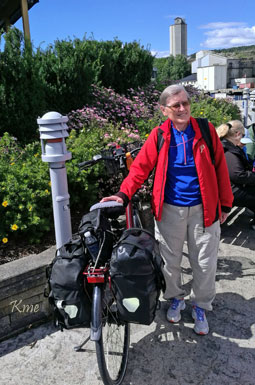 |
 |
Endelig
ombord på Pearl Seaway (DFDS). Det var godt å få satt seg etter den lange ventetiden på brygga. |

En fin kveld
I Danmark fikk syklistene kjøre i land først.
Vi begynte turen mot Helsingør, der vi skulle
bo de første dagene.
En etappe på ca 45 km.
Første stopp på turen ble ved
Charlottenlund fort og strandpark.
The Charlottenlund Battery, later referred to as the
Charlottenlund Fort, was built during the years 1886 to 1888.
It was a coastal battery and was part of the series of coastal
batteries intended to protect Copenhagen from the sea side.
It was part of the middle defence line together with the
Middelgrund Fort and the Kastrup Battery.
The Charlottenlund Fort > Vestvolden.info (31. juli 2022)


Charlottenlund Beach Park (Danish: Charlottenlund Strand Strandpark)
is a seaside public park in Charlottenlund, Gentofte Municipality, in the
northern suburbs of Copenhagen, Denmark.
The park's history as a green space dates back to 1622 when King Christian IV established "Gentofte Deer Park by the Beach" (Gentofte Dyrehave ved
Stranden). The area later came under ”Gyldenlund”, what is now called
Charlottenlund Slot.
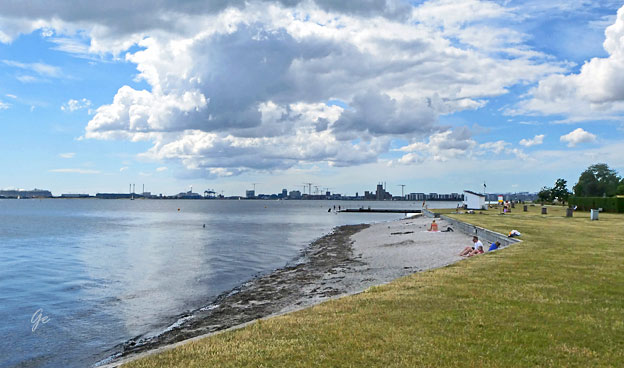
In 1886 the southern part of the area was ceded to the Ministry of Defence when Charlottenlund Fort as part of Copenhagen's new defense towards the sea.
The area to the north was leased to Frederick VIII who leveled it and used it as a
vegetable garden.
The area came into use as a public beach park in 1932. In 1950 the park was
refurbished to designs by Aksel Andersen, who served as head of the municipal
park department from 1946 until his death in 1953.
Charlottenlund Beach Park - Wikipedia (31. juli 2022)
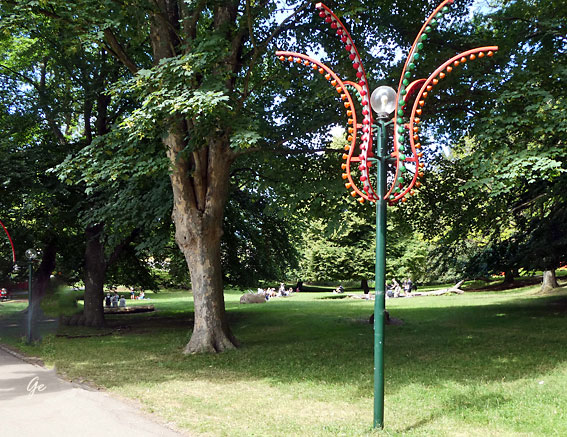
Vi tok en avstikker innom Dyrehavsbakken, Klampenborg

park in the world. Located in the woods of Dyrehaven, Bakken is a unique
amusement park, which offers a historic and nostalgic venue combined
with modern and fun amusements and thrill rides.
a firm favorite with the people of Copenhagen for centuries. During summertime
families, young couples and seniors alike flock to the amusement park and the
surrounding woodland to indulge in a day of fun.
English | Find information about Bakken in English (31. juli 2022)
| I
Vedbæk stoppet vi for å spise lunsj. |
 |
Siste stopp før vi kom til Helsingør
ble på en strand i nærheten av Humlebæk.
Så fortsatte vi inn til Helsingør
og sjekket inn på Hotel Hamlet.

 |
Hotellfrokost
med utsikt til en stor vinhandel. |
Helsingør (/ˌhɛlsɪŋˈɜːr/ HEL-sing-UR, Danish: [helse̝ŋˈøɐ̯ˀ]; Swedish: Helsingör), classically known in English as Elsinore (/ˈɛlsɪnɔːr, ˌɛlsɪˈnɔːr/ EL-sin-or, -OR),
is a city in eastern Denmark. Helsingør Municipality had a population of 62,686
on 1 January 2018.
The name Helsingør has been believed to be derived from the word hals meaning "neck" or "narrow strait," referring to the narrowest point of the Øresund
(Øre Sound) between what is now Helsingør and Helsingborg, Sweden.

The people were mentioned as Helsinger (which may mean "the people of the strait")
for the first time in King Valdemar the Victorious's Liber Census Daniæ from 1231
(not to be confused with the Helsings of Hälsingland in Sweden). Place names show
that the Helsinger may have had their main fort at Helsingborg and a fortified
landing place at Helsingør, to control the ferry route across the strait.
Helsingør - Wikipedia (31. juli 2022)

På vei inn til Kronborg Slott.
 |
 |
 |
 |
when it was completed in 1582. Kronborg - Wikipedia (31. juli 2022)
Immortalized as Elsinore in William Shakespeare's play Hamlet, Kronborg
is one of the most important Renaissance castles in Northern Europe and
was inscribed on the UNESCO's World Heritage List in 2000.
The castle is situated on the extreme northeastern tip of the island of
Zealand at the narrowest point of the Øresund, the sound between present
Denmark and the provinces of present Sweden that were also Danish at the
time the castle was built. In this part, the sound is only 4 kilometres (2.5 mi)
wide, hence the strategic importance of maintaining a coastal fortification
at this location commanding one of the few outlets of the Baltic Sea.
The castle's story dates back to a stronghold, Krogen, built by King Eric VII in the
1420s. Along with the fortress Kärnan in Helsingborg on the opposite coast of
Øresund, it controlled the entranceway to the Baltic Sea.
From 1574 to 1585, King Frederick II had the medieval fortress
radically transformed into a magnificent Renaissance castle. The main
architects were the Flemings Hans Hendrik van Paesschen and Anthonis
van Obbergen, whereas the sculptural work was coordinated by Gert van
Groningen.
In 1629, a fire destroyed much of the castle, but King Christian IV
subsequently had it rebuilt. The castle also has a church within its walls.
In 1658, Kronborg was besieged and captured by the Swedes who took
many of its valuable art treasures as war booty.
In 1785 the castle ceased to be a royal residence and was converted into
barracks for the Army. The Army left the castle in 1923, and after a
thorough renovation it was opened to the public.
Kronborg - Wikipedia (31. juli 2022)
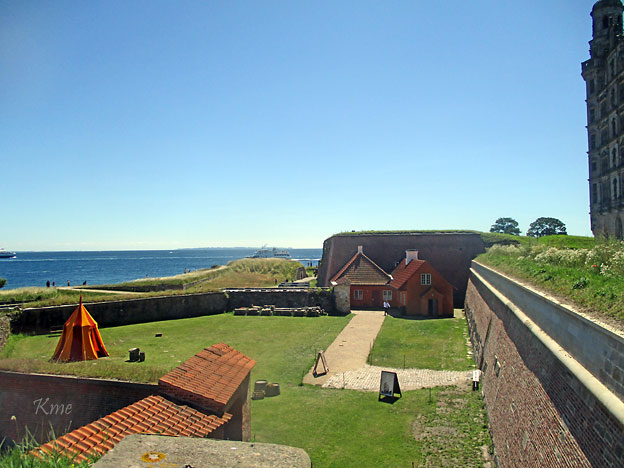
Utenfor Kronborg slott
 The story of Shakespeare's Hamlet was derived from the legend of Amleth, preserved by 13th-century chronicler Saxo Grammaticus in his Gesta Danorum, as subsequently retold by the 16th-century scholar François de Belleforest. Shakespeare may also have drawn on an earlier |
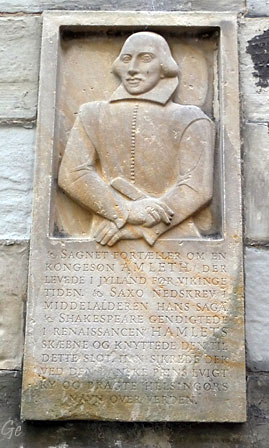 |
Shakespeare wrote the Ur-Hamlet, later revising it to create the version of Hamlet
that exists today. He almost certainly wrote his version of the title role for his fellow actor, Richard Burbage, the leading tragedian of Shakespeare's time. In the 400
years since its inception, the role has been performed by numerous highly acclaimed
actors in each successive century.
Hamlet - Wikipedia (31. juli 2022)
 Under Kronborg’s four protruding bastions lie the castle's underground passages. The casemates are gloomy, cold and damp, but have saved many lives during times of war. The underground passages have protected soldiers when enemy bullets were fired into Kronborg. Soldiers were able to barricade themselves inside the casemates for weeks. They had room for horses and soldiers and there were provisions to feed 350 men for up to six weeks. The casemates were built in 1574-76, when the medieval fortress Krogen (literally “The Hook”) was rebuilt into the renaissance castle of Kronborg. The Casemates - Explore the Castle - Kronborg Castle - Palaces and Gardens - Kongelige Slotte (31. juli 2022) |
 According to a legend linked to Arthurian myth, a Danish king known as Ogier the Dane (Danish: Holger Danske), was taken to Avalon by the enchantress Morgan le Fay. Ogier returned to rescue France from danger, then travelled to Kronborg castle, where he sleeps until he is needed to save his homeland. His beard has grown to extend along the ground. A statue of the sleeping Ogier (right) has been placed in the castle casemates. Kronborg - Wikipedia (31. juli 2022) |

Her undervises det i bruk av sverd.
Fencing, organized sport involving the use of a sword—épée, foil, or sabre—for
attack and defense according to set movements and rules. Although the use of
swords dates to prehistoric times and swordplay to ancient civilizations, the
organized sport of fencing began only at the end of the 19th century.
The earliest depiction of swordplay is a relief in the temple of Medīnat Habu,
near Luxor in Egypt, built by Ramses III about 1190 BCE.
The Romans brought sword combat to a highly systematic art that was taught
to both their legions and their gladiators. Gladiators were trained in schools
(ludi) by professional instructors (doctores). Beginners practiced with a wooden
sword called a rudis.
fencing | History, Organizations, & Equipment | Britannica (31. juli 2022)

The chapel is located in the ground floor of the south wing and was inaugurated
in 1582. In 1785, as the castle was being fitted for use as army barracks, the
chapel was fitted out as a gymnasium and fencing hall and the furniture stored
away. The chapel was refurnished with the original furniture in 1838 and reinaugurated in 1843.
Kronborg - Wikipedia (31. juli 2022)
 |
 |
 |
 |
 |
Archaeological ruins and texts
show that stiltwalking was practised in ancient Greece as far back as the 6th century BCE. The ancient Greek word for a stilt walker was κωλοβαθριστής (kōlobathristēs), from κωλόβαθρον (kōlobathron), "stilt", a compound of κῶλον (kōlon), "limb" and βάθρον (bathron), "base, pedestal". Some stilt use traditions are very old. In Namur, Belgium, stilt walkers of Namur have practiced fights on stilts since 1411. The inhabitants of marshy or flooded areas sometimes use stilts for practical purposes, such as working in swamps or fording swollen rivers. |
flocks while standing on stilts to extend their field of vision, while townspeople
often used them to traverse the soggy ground in their everyday activities.
Stilts were used by workers to attach hop grass to wires at 12 feet above the ground. This technique was documented up to the mid 20th century before being superseded.
Stilts - Wikipedia (31. juli 2022)

 The most famous aspect of the Hydra, though, was that its many heads regrew whenever the hero tried to cut them off. Without help from his nephew, and inspiration from Athena, it would have been impossible for Hercules to overcome this regenerative power. How Hercules Killed the Hydra: The Complete Guide (2022) (mythologysource.com) (31. juli 2022) |
Defeating the Hydra was the
second labor of Hercules, and it was a job
that would require both strength and wits to
accomplish. The Lernean Hydra was a nearly un-killable serpent faced by Hercules during his famous twelve labors. Its multitude of venom-spitting heads made it a dangerous foe. |

Denne dagen tok vi ferga over til Helsingborg.
På bildet ser vi Helsingør havn.
 Rudolph Tegner 1873 - 1950 Tegners talent vaktes ved mødet med den antikke kultur, da han som 15-årig besøgte Akropolis, og den antikke verden optog ham gennem hele hans kunstneriske liv. |
 Helsingør havn |
 Helsingørgater om kvelden |
 |

Kronborg slott sett fra ferga.
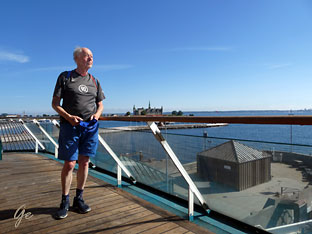 Karl Martin på ferga til Sverige. |
Øresund commonly known
in English as the Sound, is a strait which forms the Danish–Swedish border,separating Zealand (Denmark) from Scania (Sweden). The strait has a length of 118 kilometres (73 mi); its width varies from 4 kilometres (2.5 mi) to 28 kilometres (17 mi). It is 4 kilometres (2.5 mi) wide at its narrowest point between Helsingør in Denmark and Helsingborg in Sweden. Øresund - Wikipedia ((31. juli 2022) |
Helsingborg is a city and the seat of Helsingborg Municipality, Scania (Skåne),
Sweden. It is the second-largest city in Scania (after Malmö) and ninth-largest in Sweden, with a population of 113,816 (2020). Helsingborg is the central urban
area of northwestern Scania and Sweden's closest point to Denmark: the Danish city Helsingør is clearly visible about 4 km (2.5 mi) to the west on the other side
of the Øresund.
Historic Helsingborg, with its many old buildings, is a scenic coastal city. The
buildings are a blend of old-style stone-built churches and a 600-year-old
medieval fortress (Kärnan) in the city centre, and more modern commercial
buildings. The streets vary from wide avenues to small alley-ways. Kullagatan,
the main pedestrian shopping street in the city, was the first pedestrian shopping
street in Sweden.

Helsingborg is one of the oldest cities of what is now Sweden. It has been the site of permanent settlement officially since 21 May 1085. Helsingborg's geographical
position at the narrowest part of Øresund made it very important for Denmark, at
that time controlling both sides of that strait. From 1429 Eric of Pomerania
introduced the Sound Dues, a levy on all trading vessels passing through the sound
between Helsingør and Helsingborg. This was one of the main sources of income for
the Danish Crown. Crossing traffic, like fishermen, were not subject to the tax, which
was initially directed against the Hanseatic League.
Helsingborg - Wikipedia (31. juli 2022)
 Grete ved Helsingborg Rådhus. |
Helsingborg
Rådhus The building of the municipality of Helsingborg, designed by Alfred Hellerstrom, was built in 1897. The four-storey building is built in the Neo-Gothic style and the building is surrounded by four towers facing Stortorghet, more angular to Rodhustorghet, and topped by a 65-meter bell tower. Helsingborg City Hall (berloga-workshop.com) (31. juli 2022) |


 |
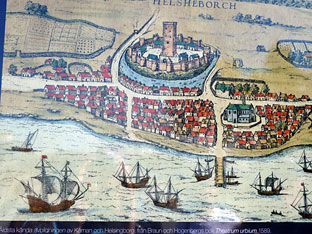 |
 |
 Tredje etasje |

The entire roof terrace was added in the years 1893-1894 in connection with
Kärnan undergoing a major renovation. Before that, the tower was a few meters
lower and ended already after the fourth floor. The top part of the high, narrow
stair tower is also from the 1890s. Regardless of how many meters up you have
been over the centuries, the view has always been fantastic. On really clear days
you can even see all the way to the Öresund Bridge today. At the top of Kärnan
you have a view of central Helsingborg and you understand why this is one of Helsingborg's most popular destinations.
The core of Helsingborg (karnan.se) (31. juli 2021)
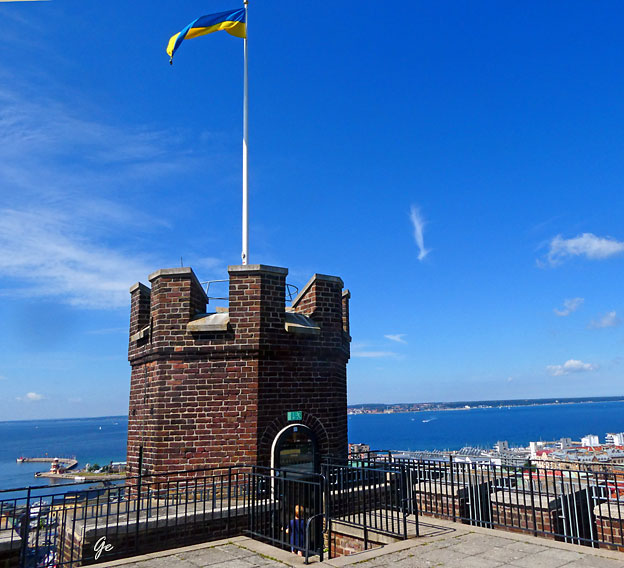
Kärnan, (Danish: Kernen, both literally The Core)
is a medieval tower in Helsingborg, Scania, in southern Sweden. It is the only part
remaining of a larger Danish fortress which, along with the fortress Kronborg on the opposite bank of the Øresund, controlled the entranceway between the Kattegat and the Øresund and further south the Baltic Sea.
Kärnan - Wikipedia (31. juli 2022)
 |
 Kärnan The origins of the Helsingborg fortress are disputed. Danish legend places its origin to the reign of the legendary King Fróði. However, this legend has not been supported by archaeological proof. Dendrochronological dating has |
integral in securing control over the strait between Scania and Zealand.
Kärnan - Wikipedia (31 juli 2022)

Axel Wallenberg, Sculpture, bronze, signed and dated 1938
 |
Skulptur
ved Helsingborg havn. Det var mange flere av samme typen. Maria (St. Mary's) Church is one of the oldest buildings in Helsingborg. The construction of the church started in the beginning of the 14th century and finished some hundred years later. The place, where the Maria church is standing today, has though been holy ever since people inhabited the area. In the end of the 12th century a little stone church was build in a Romance style, in the place were Maria church stands today. The exterior of Maria church is a good example of the Danish Brick Gothic style, which is characteristic to the Scandinavian buildings of the 14th century. The church has a form of three naves basil, though the high mid nave misses the characteristic flow of light. The two of the church's four clocks come from the St. Petri Church that has been destroyed by reformists in the 16th century. |

Mariakyrkan
If you visit the church, don't miss the triptych from the 15th century, the hoard of
silver in the basement of the vestry and a plague for the famous composer Dietrich Buxtehude - an organist at the Maria Church in the 17th century.
St. Mary's Church, Helsingborg, Sweden - SpottingHistory (24. august 2023)
 |
 John Børjeson 1835-1910  |

Stadsparken, Helsingborg
Denne dagen sykla vi en tur i Helsingørs omegn. (ca 41 km)
Først langs kysten til Ålsgårde.
Deretter fulgte vi sykkelrute 107 til Espergærde.

Strand rett utenfor Helsingør sentrum. Vi kan se Kronborg slott.

Strand mellom Helsingør og Ålsgårde.
Nå begynte sykkelturen på ordentlig.
Vi hadde noe vi måtte ordne i Helsingør før vi kom av gårde.
Derfor ble ikke første etappe så lang. Vi sykla til Gilleleje.
En strekning på ca 25 km. Dessuten 7 km i Helsingør før start.

Karl Martin kjenner på vanntemperaturen.

Disse tre bildene er tatt like etter Hornbæk.

Fra Hornbæk var det fin sykkelvei langs sjøen.
| Vi
fortsatte langs sjøen. Vi skulle gjennom Hundested til Lynæs. En strekning som skulle være ca 45 km. I Rågeleje var det omdirigering for syklister pga en festival. Veien gjennom skogen var dårlig skilta, men vi fant riktig vei. En stund skulle sykkelrute 47 gå langs sjøen, men vi møtte noen som sterkt frarådet oss å ta den veien. Det hadde blåst mye de siste dagene og det var veldig mye sand på den veien. Så da måtte vi finne alternativ rute. |
 Veldig enkel, men koselig cafe |
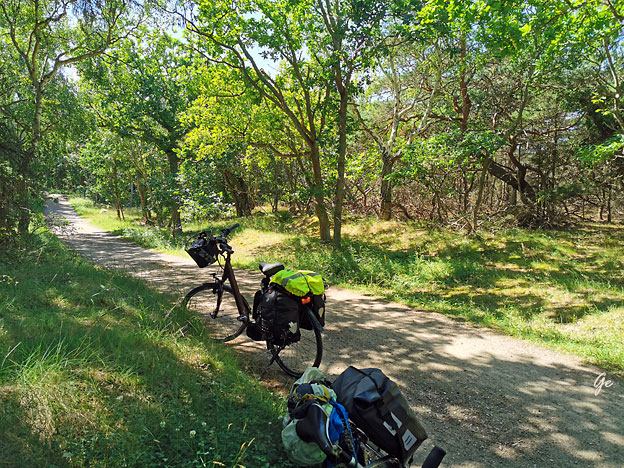
Veien gjennom skogen.

Hundested havn. Her tok vi litt godt drikke på en av de mange cafeene.
| Lynæs hotel
og kro. Her fikk vi et bra rom. De hadde også plass til syklene innendørs. |
 |

| Skoven Kirke ligger i et
naturskønt område nord for Jægerspris nær ved Nordskoven og få kilometer fra Roskilde Fjord og Isefjorden. Kirken blev bygget i 1897 i en stilart, der bliver kaldt nyromansk, da den er inspireret af middelalderen. Det var arkitekten Martin Borch, der var tilknyttet Stiftelsen på Jægerspris, der tegnede kirken ligesom han har tegnet mange af de bygninger, der ligger omkring slottet. |
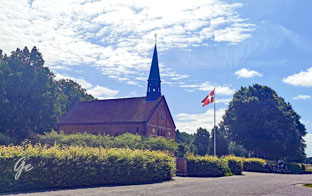 Skoven Kirke | Gerlev, Draaby og Skoven Kirker (1. august 2022) |
Fra Lynæs sykla vi til Sølager hvor vi tok ferga Columbus over til Kulhuse.
Derfra skulle vi følge sykkelrute nr 40, men her også var det dårlig merking.
Vi har tydeligvis tatt feil av veien et sted, for vi kom ut på bilveien ved Skoven kirke.
Vi valgte å følge bilveien derfra.
Vi kom forbi Julianehøj, og tok en pause der.



Julianehøj er en ombygget ganggrav (dansk: jættestue) utenfor Slotshegnet ved Jægerspris slott på Sjælland, som inngår i monumentparken Mindelunden.
Jettestuen, som opprinnelig stammer fra ca. 3000 f.Kr., ble opprinnelig kalt Monses høj og Væverhøj og ble utgravet og sterkt ombygget på slutten av 1700-tallet i regi av Arveprins Frederik og Ove Høegh-Guldberg. Det ble funnet menneskeknokler, en kobber- eller bronsedolk, samt flintredskaper.
Frederik navnga det nye monument etter sin mor enkedronning Juliane Marie.
 |
I
1782 ble en norsk runesten – den såkalte Igijos sten, funnet i 1781 i en grav ved gården Stenstad i Telemark – montert på toppen av anlegget. (trolig fra 4–500-tallet e.Kr) Julianehøj – Wikipedia (1. august 2022) |
Den opprinnelige, østvendte, inngangen ble lukket og det ble satt opp en tavle i norsk marmor over den nye portalen med innskriften: JULIANE-HØJ – TIL DEN BEDSTE
MODERS MINDE HELLIGES DETTE ÆLDGAMLE MINDESMÆRKE FUNDET I AARET MDCCLXXVI AF ARVE-PRINDS FRIDERICH.
Oppe på selve jettestuen ble det satt opp syv minnestøtter i gjellebækmarmor med
navn på de tidlige sagnkongene Skjold, Frode den Fredegode, Dan Mykillati, Harald Hårfagre, Gorm den Gamle, Harald Blåtann og Wittekind. I 1782 ble en norsk
runesten – den såkalte Igijos sten, funnet i 1781 i en grav ved gården Stenstad i
Telemark – montert på toppen av anlegget.
Den arkeologiinteresserte kronprins Frederik undersøkte også gravhaugen i april
1834. Hele monumentet ble restaurert i 1984. Osten Julanehøj er oppkalt etter monumentet.
Julianehøj – Wikipedia (1. august 2022)

Jægerspris Castle
Jægerspris Castle (Danish: Jægerspris Slot), in Jægerspris on the Hornsherred
peninsula west of Copenhagen, is a Danish manor house. It has belonged to the
Danish monarchs for most of its history which dates back to the 13th century.
In the 1850s it became a retreat for King Frederik VII and his morganatic wife
Countess Danner, who sought refuge there to escape the controversy their
marriage had caused among the establishment in Copenhagen. After the king's
death, Countess Danner turned it into an asylum for women.
Today the castle serves as a historic house museum and is also noted for its park.
Jægerspris Castle - Wikipedia (13. januar 2023)
Cafe Danner på plassen utenfor slottet.
Så fortsatte vi mot Fredrikssund hvor vi skulle
overnatte på Rådhuskroa.
Etter innsjekking tok vi en øl på Kroa.
Korteste vei å sykle er på 22 km.Vi sykla feil to ganger,
så jeg antar vi sykla ca 30 km.
 |
 |

The Viking settlement was created because the participants in Frederikssund Vikingespil wanted to expand the Viking activities with a historically correctly reconstructed village.
Here you can experience five pit houses and a longhouse as well as a plank
road and a jetty. The pit houses are small, half-buried houses with recessed
floor level (the pit). During the Viking Age, they have been used as workshops
and in some cases also as temporary housing.
You can go into the pit houses, see where the fireplace has been or shudder a
little at how little space you had at the time.
Frederikssund Viking settlement - Visit Fjordlandet (1. august 2022)
 Sykkelrute nr 2 gjennom skogen. Også denne gang var det dårlig merking, men vi fant fram her. |
 Vi kom fram til innsjøen Buresø. Her tok vi en lengre rast, og Grete bada. |
Buresø is a lake located in a tunnel valley, immediately southeast of Slangerup, where Allerød, Frederikssund and Egedal municipalities meet. The tunnel valley,
which was formed during the last ice age, runs in an east-west direction and can
be followed along Mølleåen all the way to the Øresund coast. Between Buresø
and the nearby Bastrup Sø there is a watershed. Buresø drains via Græse Å to the
west to Roskilde Fjord, Bastrup Sø drains to the east to Mølleåen. Buresø and
surroundings is part of Naturpark Mølleåen.
Buresø - Wikipedia (1. august 2022)
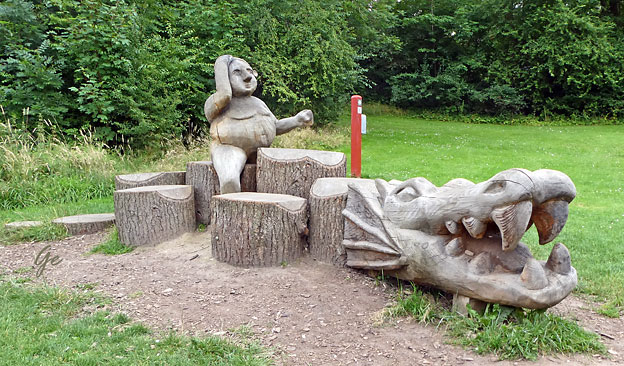
Baronen

Fisken vil tilbake til Buresø.
- Som det er
med rigmænd, er det med Baronen – han akkumulerer.
- Dragen som
flytter ind på det kunstige bjerg er modsat
Baronen
- frimodig og
nærmest kærlig, på trods af at det er en drage med
alt,
- hvad det
betyder. Vores vision for denne historie er at
udforme den
- oppustede Baronen siddende på ryggen af dragen.
som inviterer beskueren til at fodre den. Kroppen udformes af træstubbe
der former den slyngende krop. Dragen bliver ca 5 meter lang og den
skal stå på bakken ved Buresø og skue ud over søen.
Dragen og Baronen udformes af træ udelukkende med motorsav.
Frank Jæger Land (3. april 2025)
Fra Buresø fulgte vi sykkelrute nr 2 til Bastrup. Derfra valgte vi å følge bilveien gjennom Narum og videre til Herlev hvor vi skulle overnatte.
Fra Herlev hadde vi tenkt å sykle til DFD-termingalen for å ta båten hjem.
Men det var fullt på båten, så vi måtte ta en natt til i Danmark.
Dagens sykkeletappe var på ca 45 km

Vi hadde en kort sykkeltur foran oss denne dagen. Derfor tok tok vi et lengre opphold på Charlottenlund strandpark før vi sykla inn til København
Dagens etappe ca 23 km
 |
 |
Bare 5 km å sykle ut til DFDS-terminalen.
Før det fikk vi et hyggelig møte med Geir og Annette
som også var i København.
I København fikk syklistene kjøre nesten først ombord.
Godt å slippe den lange ventetiden i ombordkjøringskø.
Til høyre er et omtrentlig bilde av kjøreruta vår.
Ca 30 mil sykla vi totalt

Fra DFDS-termingalen sykla
vi korteste vei hjem til Slemmestad, 33 km.
Totalt sykla vi ca 32 mil

Vi var ikke de eneste syklistene ombord